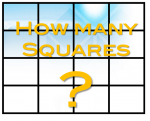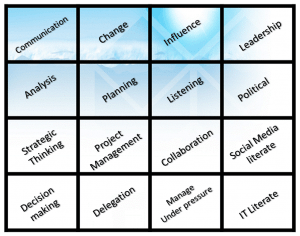Seeking the Potential of, and in our People

Many organisations use tools like the Nine Box Grid or one of the many other talent management frameworks to identify, map and ultimatly manage talented people.
But as the old saying goes – rubbish in — leads to — rubbish out.
Identifying Talent Potential
So when we are looking to identify “talent” what are we actually seeking? talent for today, tomorrow or next year? How do we know what “talent” is required next? For example, five years ago many firms had not heard of twitter, and thought facebook was a passing fad – now no reputable marketing or customer services function would be without either. How can talent be planned for and identified for these “black swan” events, or even the new skills or technologies which are there but not yet recognised an important. Or is it that we treat talent as “leadership” – and senior leadership at that?
Its about how we see our individuals, our organization and the business environment in which we operate.
What do we really see?
Many of us look at thinks and believe that what we are seeing is the “right” thing, it is only when someone shows us a different view that we sometimes change our perspective.
 We have all seen the images that show the old woman and young girl – at first we only see one – but when shown we can see both. Once we are “educated” or we have “truly learnt” something it is very difficult to “forget”.
We have all seen the images that show the old woman and young girl – at first we only see one – but when shown we can see both. Once we are “educated” or we have “truly learnt” something it is very difficult to “forget”.
For example have a look at this Image:

How many squares do you see?
16.. 17?
So how many did you see?
We need your FIRST thought.. what is your instinct, for this is the mental process we use to look for potential in people – or talent spotting if you like.
Have a second look.
Has your view changed?
This image could be akin to an employee, a team, an organization or a market. Where the number of squares that we see is the capacity or potential of the individual, org etc. so in this instance the “potential” of this individual is 16, although some of you may have thought 17 – and the very odd few of you may have thought 30.. don’t worry, I will explain all in a moment.
Have a look at this page & return when done…
How many squares?
So what are your thoughts? Are you capturing the potential of your people? is your talent management system just managing that show “16” – or is it really identifying those with much greater potential. Many mathamaticians will give you the answer 30, indeed if you look the puzzle up on the net you will see many that give that as the answer – but that is linear thinking, and identifying talent is not linear – we need to look at our resources in both creating and lateral ways.
Remember school grades rarely predicted career success – why would most talent identification approaches? As the world changes, so do the skills & attributes required. the skills that led to success just five years ago may well be the attitudes and behaviours that limit our growth today – and as for tomorrow – who knows.
Do competencies have a place in talent identification?

In recent years Human Resources functions have been developing various competency frameworks, in which to identify and “box” talent for tomorrow. This is a little like taking the 16 boxes above in the grid and writing a competence for each.. however the competency that may give the organization the edge for the future may very well be one of the other 3000+ (or even conservatively the 14 “hidden” squares).
I would argue that actually there are only a few REAL competencies:
Ability to:
- Rapidly Learn
- Adapt & Change
- Innovate
- Develop Others
- Build Collaborative Relationships
- Intrapersonal Awareness
With these “base level” competencies a person should be equiped to meet any future need. the only real difference between people is the speed and willingness at which they adapt – for leaders we need people that recognise when change is required and adapt appropriatly – not too early – and certainly not to late.
Everything else could be argued that it is a behaviour (not competence) or a learned skill – in which case anyone can learn it if the culture, environment and motivation are in place.
And let me just point out one important factor – this is NOT an age thing – its an attitude and outlook approach. It is about being flexible and adaptable, and reacting to the changes that are put upon us – but also applying our knowledge and experience to good effect. this does not mean that we just change – but we adapt fully.
How we look at people, organizations and capacity is what will give us the competitive advantage, at an individual and organizational level.


 Talentmanagement 2.0 says
Talentmanagement 2.0 says
12/01/2012 at 19:01RT @TM2Punkt0: @Leon_J absolutely “@HFMnl: #TalentManagement & Identification- who are we kidding? http://t.co/a28Qu9i7 ” @People_Dev…
 MindLeaders UK says
MindLeaders UK says
12/01/2012 at 18:59RT @TM2Punkt0: @Leon_J absolutely “@HFMnl: #TalentManagement & Identification- who are we kidding? http://t.co/a28Qu9i7 ” @People_Dev…
 Talentmanagement 2.0 says
Talentmanagement 2.0 says
12/01/2012 at 18:49@leon_j absolutely “@HFMnl: #TalentManagement & Identification- who are we kidding? http://t.co/dDKKloiT ” @People_Dev @AlanSee @GenomicsIo
 HFM says
HFM says
12/01/2012 at 18:31Talent Management & Identification – who are we kidding? http://t.co/uvatxRCs via @evandenbranden #talentmanagement
 Erik Van den Branden says
Erik Van den Branden says
12/01/2012 at 17:16Talent Management & Identification – who are we kidding? http://t.co/udRiRhJN (RT @247tweet)
 wawan maulana says
wawan maulana says
12/01/2012 at 15:03Talent Management & Identification – who are we kidding? http://t.co/XkimEXsT
 Mike D Morrison says
Mike D Morrison says
12/01/2012 at 14:55Talent Management & Identification – who are we kidding? http://t.co/XkimEXsT
 Jim Dougherty says
Jim Dougherty says
21/12/2011 at 02:21Talent Management & Identification – who are we kidding? via @RapidBI http://t.co/zEuH86nx
 Adi Gaskell says
Adi Gaskell says
14/12/2011 at 14:50I think those skills are pretty sound Mike. The American Management Association identified four key skills for the future of work last year.
-Critical thinking and problem-solving skills
-Communication skills
-Collaboration skills
-Creativity and innovation skills
http://www.amanet.org/news/AMA-2010-critcal-skills-survey.aspx
 Amm Krittikan says
Amm Krittikan says
13/12/2011 at 19:12Talent Management & Identification – who are we kidding? – http://t.co/SxTBDcfe ##cipd ##shrm ##hr ##talent
 allaboutlearning says
allaboutlearning says
13/12/2011 at 18:17“@RapidBI: Talent Management & Identification – who are we kidding? – http://t.co/IElV8XET ##cipd ##shrm ##hr ##talent”
 Mike Morrison says
Mike Morrison says
13/12/2011 at 13:20RT @energyforteams: Talent Management-what are we missing & what do we really see? A great blog from @RapidBI http://t.co/3KhY1Tt3 -thanks
 Chris Glennie says
Chris Glennie says
13/12/2011 at 12:50"@RapidBI: Talent Management & Identification – who are we kidding? – http://t.co/NsuTfhAI ##cipd ##shrm ##hr ##talent" < Really excellent
 Chris Glennie says
Chris Glennie says
13/12/2011 at 12:50"@RapidBI: Talent Management & Identification – who are we kidding? – http://t.co/NsuTfhAI ##cipd ##shrm ##hr ##talent" < Really excellent
 Lynn Soss says
Lynn Soss says
13/12/2011 at 11:04Talent Management & Identification – who are we kidding? – http://t.co/R06iDDMv ##cipd ##shrm ##hr ##talent
 TMSDI says
TMSDI says
13/12/2011 at 11:00Talent Management – what are we missing and what do we really see? A great blog from @RapidBI http://t.co/Anu6Tidz
 Trevor B Lee says
Trevor B Lee says
13/12/2011 at 10:37"@RapidBI: Talent Management & Identification – who are we kidding? – http://t.co/NsuTfhAI ##cipd ##shrm ##hr ##talent" < Really excellent
 inspiredminds2011 says
inspiredminds2011 says
13/12/2011 at 05:59Talent Management succession planning is very good for the personality development.resource training and development is important issue in the business development.
 Abbas Raza ✔ says
Abbas Raza ✔ says
13/12/2011 at 04:01Talent Management & Identification – who are we kidding? – http://t.co/iZgTomzr ##cipd ##shrm ##hr ##talent
 Mons†er モンスター says
Mons†er モンスター says
13/12/2011 at 02:25Talent Management & Identification – who are we kidding? – http://t.co/iZgTomzr ##cipd ##shrm ##hr ##talent
 ☮Dåяiℴ LiLMons†er says
☮Dåяiℴ LiLMons†er says
13/12/2011 at 02:25Talent Management & Identification – who are we kidding? – http://t.co/iZgTomzr ##cipd ##shrm ##hr ##talent
 Heather Townsend says
Heather Townsend says
12/12/2011 at 12:39RT: @rapidbi Talent Management & Identification – who are we kidding?: Talent management is a little like asking… http://t.co/vzSTo8eZ
 John Mooney says
John Mooney says
12/12/2011 at 10:58Very informative article as more and more companies want additional functionality from their recruitment systems to enhance employee abilities.
 Sharon Gaskin says
Sharon Gaskin says
12/12/2011 at 10:51RT@rapidbi Talent Management & Identification – who are we kidding?: Talent management is a little like asking -… http://t.co/r9Qhgyti
 Duncan Brodie says
Duncan Brodie says
12/12/2011 at 10:48New Blog post: Talent Management & Identification – who are we kidding? http://t.co/M1lwqLkK
 Alex Raymond says
Alex Raymond says
12/12/2011 at 10:37How many square do YOU see? RT @rapidbi: New Blog post: Talent Management & Identification – who are we kidding? http://t.co/M2BSOVRL
 hypnosis2help_Anne M says
hypnosis2help_Anne M says
12/12/2011 at 10:24Get you thinking on a Monday morning? http://t.co/eKpKHuwb